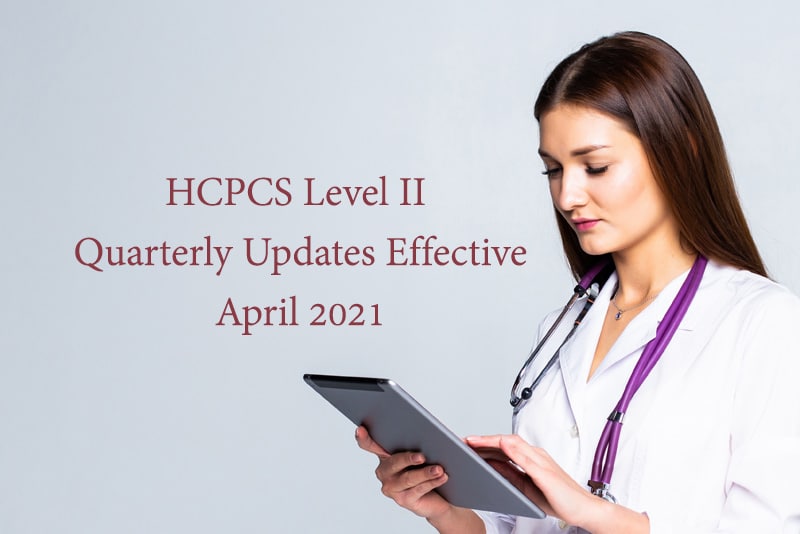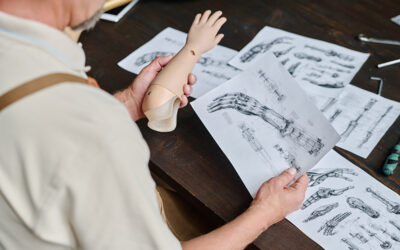This is an update to the blog, “Key HCPCS Code Changes Effective January 1, 2019”
HCPCS or Healthcare Common Procedure Coding System represents medical procedures, supplies, products and services and are used to facilitate the processing of health insurance claims by Medicare and other insurers. An experienced physician billing company will be up to date with all the CPT, ICD and HCPCS coding changes to submit accurate claims. While HCPCS Level I comprise Current Procedural Terminology® codes (HCPT), Level II HCPCS codes identify products, supplies, and services not included in CPT. Current Dental Terminology codes are included in the Level II codes as HCDT.
CMS recently announced a second quarter update to the HCPCS Level II code set used for reporting products, supplies, and services. 23 codes are added to these categories and additionally, six codes are revised and 12 are discontinued, effective April 1, 2021. The 2021 Official HCPCS Level II Expert Code Book by CMS is an essential key to quality measures, durable medical goods, injectable drugs, outpatient surgery, Medicaid, Blue Cross/Blue Shield, and many other codes.
HCPCS Level II Code Updates
New codes added are –
- A9592 Copper cu-64, dotatate, diagnostic, 1 millicurie
- C9074 Injection, lumasiran, 0.5 mg
- C9777 Esophageal mucosal integrity testing by electrical impedance, transoral (list separately in addition to code for primary procedure)
- G2020 Services for high intensity clinical services associated with the initial engagement and outreach of beneficiaries assigned to the sip component of the pcf model (do not bill with chronic care management codes). CMS recommends that the G2020 service must be provided and billed at least one day before any other services subject to the flat visit fee may be reimbursed accordingly.
- G2172 All inclusive payment for services related to highly coordinated and integrated opioid use disorder (oud) treatment services furnished for the demonstration project
- J1427 Injection, viltolarsen, 10 mg
- J1554 Injection, immune globulin (asceniv), 500 mg
- J7402 Mometasone furoate sinus implant, (sinuva), 10 micrograms
- J9037 Injection, belantamab mafodontin-blmf, 0.5 mg
- J9349 Injection, tafasitamab-cxix, 2 mg
- K1013 Enema tube, any type, replacement only, each
- K1014 Addition, endoskeletal knee-shin system, 4 bar linkage or multiaxial, fluid swing and stance phase control
- K1015 Foot, adductus positioning device, adjustable
- K1016 Transcutaneous electrical nerve stimulator for electrical stimulation of the trigeminal nerve
- K1017 Monthly supplies for use of device coded at k1016
- K1018 External upper limb tremor stimulator of the peripheral nerves of the wrist
- K1019 Monthly supplies for use of device coded at k1018
- K1020 Non-invasive vagus nerve stimulator
- M0245 Intravenous infusion, bamlanivimab and etesevimab, includes infusion and post administration monitoring
- Q0245 Injection, bamlanivimab and etesevimab, 2100 mg
- Q2053 Brexucabtagene autoleucel, up to 200 million autologous anti-cd19 car positive viable t cells, including leukapheresis and dose preparation procedures, per therapeutic dose
- S1091 Stent, non-coronary, temporary, with delivery system (propel)
Codes such as K1013, K1014, K1015, K1016, K1017, K1018, K1019 and K1020 are a result of stakeholder requests at CMS’ HCPCS Public Meeting. Code K1019 replaces A4595 for reporting replacement components of the wrist-worn connector.
Revised Codes
Also in the April 2021 update are several code descriptor changes, listed here:
- C9761 Cystourethroscopy, with ureteroscopy and/or pyeloscopy, with lithotripsy, and ureteral catheterization for steerable vacuum aspiration of the kidney, collecting system, ureter, bladder, and urethra if applicable
- G9868 Receipt and analysis of remote, asynchronous images for dermatologic and/or ophthalmologic evaluation, for use only in a Medicare-approved cmmi model, less than 10 minutes
- G9869 Receipt and analysis of remote, asynchronous images for dermatologic and/or ophthalmologic evaluation, for use only in a Medicare-approved cmmi model, 10-20 minutes
- G9870 Receipt and analysis of remote, asynchronous images for dermatologic and/or ophthalmologic evaluation, for use only in a Medicare-approved cmmi model, more than 20 minutes
- J7321 Hyaluronan or derivative, hyalgan, supartz or visco-3, for intra-articular injection, per dose
Deleted HCPCS Level II Codes
Effective April 1, 2021, these codes are discontinued:
- C9068 Copper cu-64, dotatate, diagnostic, 1 millicurie
- C9069 Injection, belantamab mafodontin-blmf, 0.5 mg
- C9070 Injection, tafasitamab-cxix, 2 mg
- C9071 Injection, viltolarsen, 10 mg
- C9072 Injection, immune globulin (asceniv), 500 mg
- C9073 Brexucabtagene autoleucel, up to 200 million autologous anti-cd19 car positive viable t cells, including leukapheresis and dose preparation procedures, per therapeutic dose
- C9122 Mometasone furoate sinus implant, 10 micrograms (sinuva)
- J7333 Hyaluronan or derivative, visco-3, for intra-articular injection, per dose
- J7401 Mometasone furoate sinus implant, 10 micrograms
- K1010 Indwelling intraurethral drainage device with valve, patient inserted, replacement only, each
- K1011 Activation device for intraurethral drainage device with valve, replacement only, each
- K1012 Charger and base station for intraurethral activation device, replacement only
OPPS Update
CMS has established the new HCPCS Level II code “C9776” in the hospital Outpatient Prospective Payment System (OPPS) update. The OPPS status indicator for this code is N.
- C9776 Intraoperative near-infrared fluorescence imaging of major extra-hepatic bile duct(s) (e.g., cystic duct, common bile duct and common hepatic duct) with intravenous administration of indocyanine green (icg) (list separately in addition to code for primary procedure)
OPPS status indicator corrections for HCPCS Level II codes G2061-G2063 and CPT® codes 98970-98972 are –
- Status indicator D is assigned to G2061-G2063 and status indicator A is assigned to 98970-98972, effective Jan. 1, 2021
- G2010 and G2012 codes that were incorrectly assigned to status indicator A were replaced with G2250 and G2251, effective Jan. 1, 2021. These codes for certain non-physician practitioners, including rehab therapists are assigned to status indicator B under OPPS to indicate that other more appropriate codes should be reported
- Complexity code G2211 is correctly assigned to status indicator B to indicate that it shouldn’t be payable under OPPS because it is an add-on code to existing evaluation and management codes that are assigned to status indicator B
- Q5122 Injection, pegfilgrastim-apgf, biosimilar, (nyvepria), 0.5 mg from Jan. 1, 2021, through March 31, 2021, is retroactively changed from E2 to K in the April I/OCE
- Status indicator for CPT® code 0632T Transcatheter Ultrasound Nerve Ablation Procedure is changed from E1 (not payable by Medicare) to J1 (hospital Part B services paid through a comprehensive APC) and is assigned to APC 5194, effective April 1, 2021
- Status indicator for CPT® code 81599 is E1 and the status indicator for 81529 is A, effective Jan. 1, 2021
Get to know more about these updates at cms’ official website-
https://www.cms.gov/Medicare/Coding/HCPCSReleaseCodeSets/HCPCS-Quarterly-Update
CPT and HCPCS coding changes happen each year. Healthcare entities must ensure that the medical coding company they partner with provides regular training for coders and billing specialists to be aware of these changing billing and coding standards.




